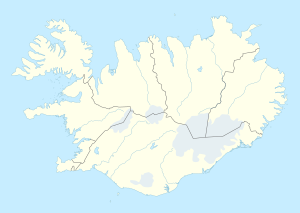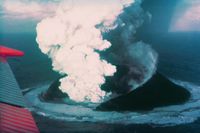World Heritage in Iceland
World Heritage Sites in Iceland |
The World Heritage in Iceland (as of 2019) includes three UNESCO World Heritage sites , including one World Heritage Site and two World Natural Heritage sites. Iceland ratified the World Heritage Convention in 1995, and the first World Heritage site was added to the World Heritage List in 2004. The third and so far last World Heritage Site was registered in 2019.
World heritage sites
The following table lists the UNESCO World Heritage Sites in Iceland in chronological order according to the year of their inclusion on the World Heritage List (K - cultural heritage, N - natural heritage, K / N - mixed, (R) - on the Red List of World Heritage in Danger ).
![]() Map with all coordinates of World Heritage Sites: OSM
Map with all coordinates of World Heritage Sites: OSM
| image | designation | year | Type | Ref. | description |
|---|---|---|---|---|---|
|
Þingvellir National Park ( location ) |
2004 | K | 1152 | Þingvellir is located 40 km east of Reykjavík . The traditional Althing Legislative Assembly has taken place here since 930 . | |
|
Surtsey Island ( location ) |
2008 | N | 1267 | Surtsey is a volcanic island that was formed on November 14, 1963. On the island, research is being carried out into how new land is conquered by living beings. | |
|
Vatnajokull National Park ( location ) |
2019 | N | 1604 | Vatnajökull is Europe's largest glacier with a surface area of 8,100 km². The uniqueness of the 14,200 km² Vatnajökull National Park lies mainly in its great variety of scenic features, which were created by a combination of rivers, glaciers, volcanism and geothermal activity. The Jökulsá á Fjöllum riverbed and the northern Dettifoss - Ásbyrgi part of the Vatnajökull National Park were not registered. |
Tentative list
The sites that are intended for nomination for inclusion in the World Heritage List are entered in the tentative list .
Current World Heritage candidates
Currently (2019) six sites are entered in the tentative list of Iceland, the last entry was in 2013. The following table lists the sites in chronological order according to the year they were included in the tentative list.
![]() Map with all coordinates of current World Heritage candidates: OSM
Map with all coordinates of current World Heritage candidates: OSM
| image | designation | year | Type | Ref. | description |
|---|---|---|---|---|---|
|
Breiðafjörður nature reserve ( location ) |
2011 | K / N | 5585 | About half of Iceland's tidal range is here and the tidal range can reach 6 m. The large intertidal zone has significant biodiversity as well as a particularly large number of individual specimens. The island of Flatey is significant . In the Middle Ages there was an abbey of Augustinian canons on it . The island was also an important trading center for centuries. | |
|
Mývatn and Laxá ( location ) |
2011 | N | 5586 | Lake Mývatn takes its name from the sometimes very large swarms of mosquitoes in summer, which are the basis for the considerable abundance of fish and the diverse duck population. Many bird species breed in this region. The Laxá í Aðaldal is the outflow of the lake. Around the lake you can see pseudocraters and various lava formations on islands and peninsulas . | |
| Viking monuments and sites | 2011 | K | 5587 | The Þingvellir National Park , which is already individually recognized as a World Heritage Site (Ref. 1152 ), is proposed as part of an international World Heritage site that includes nine Viking sites from six countries. Þingvellir's importance lies in the Althing, which has been meeting here since 930 . | |
| Þingvellir National Park | 2011 | N | 5588 |
Þingvellir is located in the middle of a rift zone ( rift zone ) and surrounded by four active volcanic systems. Here the drifting apart of the American and European tectonic plates through imposing rock crevices and cracks becomes visible. There are many fish in Lake Seeingvallavatn .
The national park, already recognized as a World Heritage Site (Ref. 1152 ), is also proposed as a World Heritage Site. |
|
| The Torfhof tradition | 2011 | K | 5589 | Due to a lack of wood in Iceland, this special house shape developed. It was widespread across the country and was inhabited until the middle of the 20th century. There are 14 individual monuments, including the Víðimýri farm, which was proposed individually in 2001
|
|
|
Torfajökull volcanic system / Fjallabak nature reserve ( location ) |
2013 | N | 5817 | The Torfajökull is a 1,190 meter high active volcano in southern Iceland. It is only partially covered by the eponymous glacier with an area of 15 km². The warm springs of Landmannalaugar belong to his area . Part of the area around the volcano is protected as the Fjallabak nature reserve. |
Former World Heritage candidates
These sites were previously on the tentative list, but were withdrawn or rejected by UNESCO. Sites that are included in other entries on the tentative list or that are part of world heritage sites are not taken into account here.
![]() Map with all coordinates of former World Heritage candidates: OSM
Map with all coordinates of former World Heritage candidates: OSM
| image | designation | year | Type | Ref. | description |
|---|---|---|---|---|---|
|
Gásar ( location ) |
2001-2011 | K | 1608 | Gásar, located south of the mouth of the Hörgsá River, was the most important port and trading center in Northern Iceland in the Middle Ages. The place was mentioned in writing for the last time in 1391. | |
| Reykholt | 2001-2011 | K | 1609 | Reykholt was one of the spiritual centers of the island in the Middle Ages | |
| Herðubreið and Askja | 2001-2011 | N | 1612 | The volcanoes Herðubreið and Askja |
Web links
- Iceland on the UNESCO World Heritage Center website.
Individual evidence
- ↑ Iceland. In: whc.unesco.org. UNESCO World Heritage Center, accessed July 7, 2017 .
- ^ Tentative list of Iceland. In: whc.unesco.org. UNESCO World Heritage Center, accessed July 7, 2017 .
- ^ Former Tentative Sites of Iceland. In: World Heritage Site. Retrieved July 7, 2017 .













